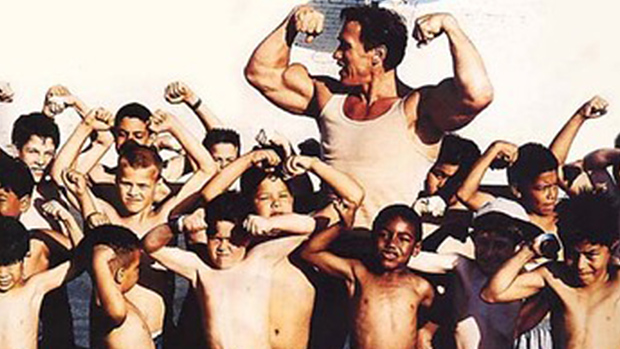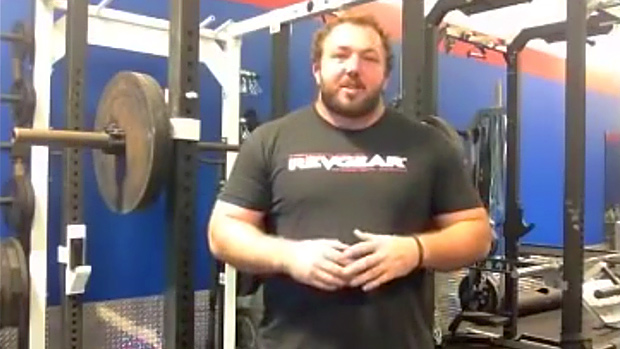When was the last time you performed singles in your training
plan? If you're a strength athlete, your answer might just be,
"last Thursday." But if you're someone who simply wants to get
bigger and stronger, without necessarily ever competing, training
with singles has probably never crossed your mind.
I want to change that.
Let me first define what a "single" is. It's one
repetition.
 |
A rather heavy "single."
Okay, that was easy. Let's move on.
Me and My Friends
For years, Pavel Tsatsouline, Charles Staley, and I (to name a
few) have been extolling the virtues of cutting reps and adding
sets. The ten sets of three (10x3) method is very popular because
it works.
We all know that 3x10 has its values, but sometimes the best
solution to your problem is to do the "opposite."
Now, let me say that 10x3 really isn't the opposite of 3x10.
Both consist of 30 total reps, and the maximum load you can use for
either method really isn't too far apart (76-84% of your one
repetition maximum [1RM]). For example, most people can do 3x10
with 76-80% of their 1RM.
But with 10x3, you can usually up the load to 80-84% of your
1RM. Sure, that might not sound like much, but the muscle and
strength gains that people experience with 10x3 compared to 3x10 is
proof enough that the extra few pounds makes a big difference.
So it makes sense to increase the load even further, and keep
the volume as high as possible.
Cutting Reps
I've been experimenting with singles for quite a spell. I always
come back to singles with my clients and myself when the ultimate
goal is size and strength, simultaneously. The reason why singles
are so effective is because they keep fatigue in check, even when
you're training with heavy weights.
When you do a single, endurance is never a limiting factor. Even
sets with typically low reps (4-6) can crank up a person's
anaerobic glycolysis if a compound exercise is used, the sets are
high, and the rest periods are short. That's great for fat loss and
boosting your anaerobic threshold, but sometimes we want to limit
those factors in favor of heavier loads and bigger
muscles.
The problem is, most people equate singles with a very low
number of sets. If you want to get big, you must train with
sufficient volume. Three or four sets of singles won't do jack shit
for your muscle mass. You need more sets.
Many, many, many more.
Volume and Mass
Virtually any training load will build muscle if you perform
enough volume. Ten sets of ten will make your muscles bigger. So
will 4x25, 2x50, and 1x100. But if you spend any more than a week
or two with such parameters, your maximal strength will tank
quicker than a movie starring Pauly Shore.
 |
So the answer to training for size and strength simultaneously
is simple: train with heavy loads and sufficient volume.
This approach supports the postulate that a certain amount of
fatigue is necessary for hypertrophy. More sets result in more
fatigue. The key is to balance out the volume and fatigue as much
as possible. I've experimented with singles enough to know how many
reps you'll need to induce enough fatigue for growth, but not so
much that it burns you out.
To maintain your maximal strength, the training load must be at
least 80% of your 1RM. But a much better alternative is to augment
that number to the 85-90% range.
How do you get sufficient volume with such a large load?
Singles!
Choose Your Weapon
For this program you'll be performing a lot of sets: 20-24. That
doesn't leave room for any movements that don't work tons of muscle
groups at once. Your exercise selection must be as efficient as
possible.
Here are the movements you should choose from, separated into
two categories (A and B).
A Movements:
Push press
Dip
Chin-up or pull-up
Row
B Movements:
Clean
Snatch
Deadlift
Squat
You can use any variations of the above movements. For example,
you can do a back squat, front squat, overhead squat, Zercher
squat, etc.
 |
 |
The Zercher squat
You'll choose one movement from each category, as I'll outline
later.
Load Your Weapon
The load (weight) you should use for these workouts is 85-90% of
your 1RM. If you're new to singles, or if you haven't been training
with heavy weights since Walter Mondale's presidential bid, stick
with the lower end of the spectrum. If you're well conditioned, aim
for 88-90%.
However, you can use 80% of your 1RM for the first few workouts
until you get the hang of it. But bump up your weight to 85% after
the first week.
Frequency and Supplementation
Since you'll be training with heavy loads for all workouts, I
recommend a frequency of no more than three workouts per week. You
can start with two workouts per week for the first week, but you'll
need to add in a third workout. Here's one that works well to
complement the other two singles workouts for the first
week.
Load: medium (a weight you could lift 10-12 times before
failure)
A1) Dip
Rest 45 seconds
A2) Chin-up
Rest 45 seconds
A3) Deadlift
Rest 45 seconds
A4) Reverse lunge
Rest 60 seconds and repeat three more times
After one week of training heavy for two workouts, drop the
above workout and perform three heavy workouts with
singles.
It's very difficult to train heavy for more than 3-4 weeks
before you need a break. You can burn out fast with nothing but
heavy weights. Therefore, supplementing with the following protocol
will make a big difference in terms of your results and
recovery.
Do the following before and after every workout.
2-3 hours before training
Consume a meal with a caloric balance of carbohydrates, protein,
and fat.
5-15 minutes before training
Consume 10 grams of branched-chain amino acids (BCAAs) with 1/2 serving
of Surge.
Take 10 grams (8 tablets) right before you begin your
training.
5-15 minutes after training
Consume 10 grams of BCAAs with 1/2 to 1 serving of Surge and 5
grams of creatine.
45-60 minutes after training
Consume 40 grams of protein powder with 1/2 cup
raisins.
Program Structure
Choose one movement from the A category and one from the B
category for each workout. Use a different movement for all three
workouts each week.
If your workout consists of nothing more than the two movements
for 20-24 sets, you'll be in great shape. However, you can always
throw in supplemental work at the end of the workouts. You can't go
wrong with external rotations, hip abduction, side lunges, and
serratus work. The supplemental exercises are up to you. Perform no
more than 3-4 sets of 8-10 reps.
The rest periods are short (30 seconds) for the movements with
singles. Intuitively, it seems that you'd need longer rest periods
since the load is heavy. This is not the case, as you'll soon find
out. You'll be amazed at how fast your nervous system jacks up its
output once you get the first 8-10 sets under your belt. Now, I'm
not saying these workouts will be easy. They won't. But no one ever
built an incredible physique without a little blood, sweat and
tears.
Here's a sample plan for the workout with singles and
supplemental exercises.
MONDAY
Sets: 20
Rest: 30 seconds between each set
Load: 85-90% 1RM
Power clean
Dip
Sets: 3
Reps: 8
Rest: 30 seconds between each exercise
Load: as heavy as possible
A1) External rotation
A2) Hip abduction
A3) Reverse crunch
WEDNESDAY
Sets: 20
Rest: 30 seconds between each set
Load: 85-90% 1RM
Overhead squat
Chin-up
Sets: 3
Reps: 8
Rest: 30 seconds between each exercise
Load: as heavy as possible
A1) Calf raise
A2) Reverse curl
A3) Woodchop
FRIDAY
Sets: 20
Rest: 30 seconds between each set
Deadlift
Push press
Sets: 3
Reps: 10
Rest: 30 seconds between each exercise
Load: as heavy as possible
A1) Push-up plus
Note: this is just a push up while pushing your shoulder blades
apart at the top of the movement.
A2) EZ bar reverse curl
A3) Side lunge
Progression
Week 2: increase load 2% and perform 22 sets with all A and B
exercises.
Week 3: increase load 2% and perform 24 sets with all A and B
exercises.
Week 4: return to higher rep training for 3
weeks.
Singles for Specialization
Up to this point, I've outlined a kickass total body plan to
boost size and strength. However, you might not need to add overall
mass. Maybe you just want to bring up a lagging body part or
two?
 |
Decent overall mass, but with one or two lagging
parts.
Well, you're in luck. If you perform 24 sets of heavy singles
for a lagging muscle group, it'll get big – fast! Such an
approach, however, won't leave much time for anything else. So you
might want to simply add in the 24x1 method to your current plan on
an off day, especially if it's a split routine.
Let's say you want to boost your biceps. Here's what you'll do
for two workouts each week.
Workout 1
Sets: 24
Rest: 20 seconds
Load: 85-90% 1RM
Reverse curl
Workout 2 (3-4 days later)
Sets: 24
Rest: 20 seconds
Load: 85-90% 1RM
Hammer curl
You can, of course, use any isolation movement you want,
depending on your weaknesses. Just be sure to use a different
movement for each of the two workouts.
Time Factor
Make no mistake: a singles workout isn't exactly quick. That's
why it's important to use compound movements, and only two of them
per workout. Supplementing with the above protocol is also
essential for enhancing recovery.
The specialization workouts are even tougher because you'll be
spending about 15 minutes just training one muscle group. But if
that muscle group is lagging, it needs a lot of attention. Heavy
singles will certainly build up your lagging muscle groups,
although you'll need to manage your time with other
exercises.
Conclusion
Building a bigger, stronger, leaner body takes tough workouts.
These workouts are indeed challenging because they won't be
finished in less than hour. So if you have the time, follow this
plan because it will make you bigger and stronger!





